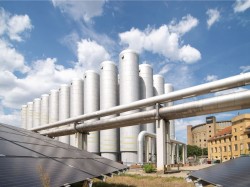Big boilers from Reick
Thomas Dautert stands in the innovation power plant Dresden – where one and a half years ago a large excavation pit was still gaping, now grey storage tanks tower up almost 30 metres – announcing that the municipal energy supplier DREWAG is expanding its district heating network. The 42-year-old specialist manages the project. Built in 1985, DREWAG already stored up to 6,600 cubic metres of hot water for optimised operation of the district heating network and the power plants. With the 20 new towers, the capacity has been more than doubled. "The transport was particularly demanding," he says. The containers, each weighing 100 tons, were manufactured by a specialist company in Bielefeld. They came to Dresden on ships via the German Mittelland Channel. The originally planned route on the river Elbe was rejected. So the heavy transports had to travel from Dresden harbour through the city to the building site. This was only possible from the end of November, when the arch of an ancient bridge was torn down. The last two towers had to take a detour over the Neustadt side of the river Elbe, as from the end of February the scaffolding for the new bridge arch was already in place and there was no way through. The last towers were positioned in April this year. To ensure that the heat is well stored, fitters packed the steel containers in three-layer mineral wool, protected under the outer skin made of grey aluminum sheet. Some of the scaffolding is still towering. However, they can soon be dismantled. This Monday the towers were inspected for acceptance. Among other things, the fastening of the sheets and pipes was tested, Dautert cites an example. Most of the containers are already filled with water. However, this could only be done step by step from the inner towers to the outer towers in order to evenly load the base plate, since a total weight of 7,800 tons is added. The base plate had only sunk by one centimetre, the surveyors concluded. So, the trial operation of the first two tanks could start in July, followed by the others next month. "All plants are to be fully commissioned in October – on time before the heating period," says the project manager. A special measurement technology is also installed, financed by the EU funding project "MAtchUP" being coordinated by the Economic Development Office of the City of Dresden. The hot water flows through four tanks, which are connected by the pipeline system as a so-called road. On one of them, a 300-metre-long fibre optic cable was laid on the walls of the tower. Temperatures are determined for every second. Together with TU Dresden, the data will be evaluated. "This optimises the system and thus reduces heat consumption," Dautert calls the effect. More than 90% of district heating comes from Dresden's eight CHP plants. A gas turbine drives a generator that generates electricity; the waste heat is used to generate district heating. With the new tanks, much more excess hot water can be stored during times when it is not needed. The DREWAG facilities are thus better utilised. Green energy converted into hot water from solar or wind power plants can also be better stored temporarily. Eight million euros will be invested in the project. "In the end, we are happy that everything went so quickly," Dautert sums up. The MAtchUP project secured the financing of the monitoring and thus optimisation of the running system. Read more: http://www.matchup-project.eu/news/big-boilers-from-reick/(opens in new window)
Keywords
Countries
Germany



